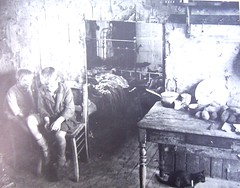Joris Ivens @110
Joris Ivens (1898–1989) was a Dutch documentary filmmaker and devout communist. He is internationally known as a foremost documentarist of the early twentieth century, noted for his co-direction of the political film Misère au Borinage, which I had the pleasure of screening in class last year.
Borinage is noteworthy in media theory because it proves the inherent ficticiousness of the documentary film.
Like most documentaries, it mixes reality and fiction, and in this case, contrary to authorial intention. For the film, the two directors had arranged a manifestation with extras from the Borinage. The miners were to walk behind a portrait of Karl Marx. The police mistook it for a real manifestation, they intervened and the “protest” was dispersed. This was filmed by Ivens and Storck.
It would cause Walter Benjamin to write in The Work of Art in the Age of Mechanical Reproduction:
“Similarly, the newsreel offers everyone the opportunity to rise from passer-by to movie extra. In this way any man might even find himself part of a work of art, as witness Vertov‘s Three Songs About Lenin or Ivens Borinage.”
Foretelling Andy Warhol’s famous 15 minutes dictum, Benjamin added that “Any man today can lay claim to being filmed.”
[Youtube=http://www.youtube.com/watch?v=d4mvpRDp6wk&]
Rain, accompanied by unknown beats.
If Borinage is a Blakean dystopian “and did those feet” anti-industrialization document, Ivens also made Rain, a much more impressionist affair, generally considered a “city symphony,” a loosely outlined genre typified by Manhatta (1921) and Berlin: Die Sinfonie der Großstadt, (1927).
There was a tremendous fascination with the metropolis, the big city during the 1920s and 1930s, dubbed fittingly for this context, as the Machine Age. Mostly associated with visual culture such as the decorative style Art Deco, the arts movement Cubism, Streamline Moderne appliance design and architecture and Bauhaus style; there were also the films including Chaplin’s Modern Times and Lang’s Metropolis.
Often overlooked are the “city novels,” mostly labeled a modernist subgenre but in reality as old as the novels of Charles Dickens. For our purpose I include Rainer Maria Rilke’s The Notebooks of Malte Laurids Brigge (1910), John Dos Passos‘s Manhattan Transfer (1925), Alfred Döblin’s Berlin Alexanderplatz (1929), James Joyce’s Ulysses (1922) and T. S. Eliot’s vision of London in The Waste Land (1922). Especially John Dos Passos‘s Manhattan Transfer (1925) is of importance here as it offers the most positive view of the dynamics of speed, the modern way of life and the unavoidable fragmentation of existence.
While writing this post, the painting below was constantly on my mind. Paris in the rain. That why Paris invented arcades, and Benjamin could write about the romantic mediatic aspects of the city.
Gustave Caillebotte: Urban Impressionist (1995) – Anne Distel
[Amazon.com] [FR] [DE] [UK]


